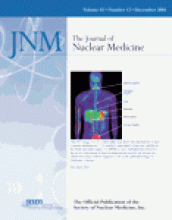TO THE EDITOR:
The work that van der Weerdt et al. (1) reported in the article “Postinjection transmission scanning in myocardial 18F-FDG PET studies using both filtered backprojection and iterative reconstruction” has afforded useful and needed results on this topic. It is indeed surprising that so important a study had not been conducted before.
The study had an additional aim: “to compare images reconstructed with both standard filtered backprojection (FBP) and an iterative reconstruction algorithm based on ordered-subset expectation maximization (OSEM)” (1). FBP reconstructions have been performed with the classic Hanning filter at 0.5 of the Nyquist frequency and OSEM reconstructions with 2 iterations and 12 subsets. This configuration of OSEM is equivalent to 24 iterations with the maximum-likelihood expectation maximization (MLEM) algorithm (2). It has clearly been demonstrated that such a low number of iterations generates reconstructed images with a low noise level but at the expense of a biased contrast (3). The convergence speed of MLEM and OSEM depends on the number of counts and is slower for the low-count regions than for the high-count regions (3,4).
In view of the number of iterations used by van der Weerdt et al. (1), it could be anticipated that no region had reached the convergence. This could explain the systematically lower value for the 18F-FDG uptake recorded on OSEM reconstructed slices (Tables 1 and 2). The encountered differences are limited and not always statistically significant, but they are pointed out 3 times by van der Weerdt et al. (1) in the “Results” section. In Figure 2D, the largest differences in 18F-FDG uptake between FBP and OSEM slices appear to be recorded for the segments with the lowest uptake. This observation could clearly result from the slower convergence of these low-count regions.
In conclusion, one might suggest that the number of subsets and iterations chosen should be close to the convergence for all studied regions before quantitative comparisons are made between FBP and OSEM. The number of requested iterations will probably result in images that are too noisy, and a postprocessing filter should be applied (3).
REFERENCES
REPLY:
Our paper addresses the effect of emission spillover into transmission scans (1). In addition, a comparison between data reconstructed using FBP and OSEM was made. For OSEM reconstructions, the small number of 24 expectation-maximization-equivalent iterations (2 iterations and 12 subsets) was applied. Prof. Seret is correct in stating that by using such a small number of iterations, full convergence has not been reached and biased contrast will result. However, several considerations may justify the use of a small number of iterations.
First, the (pixel) variance properties of OSEM, as compared with FBP, were considered. It has been demonstrated that for large background regions with low uptake (e.g., soft tissue), pixel variance of OSEM-reconstructed data is lower than that of FBP. That explains the successful use of OSEM for reconstruction of oncology whole-body studies; that is, the low variance in the background improves the detection of small tumors. However, Boellaard et al. (2) and Riddell et al. (3) have shown that for small objects (<5-cm diameter) such as tumors or myocardium, pixel variance obtained with OSEM, already at a low number of iterations, is worse than that obtained with FBP. Increasing the number of iterations to ensure convergence will further increase variance, which may be reduced by additional postprocessing smoothing of the images. To obtain approximately equal variance at pixels located in the myocardium between fully converged OSEM and FBP data, more filtering of OSEM than of FBP reconstructed images would be required. The resulting lower resolution of OSEM images than of FBP images would result in biased contrast (worse cold-spot recovery) as well.
Second, van der Weerdt et al. (1) showed that using OSEM with only 24-emission-equivalent iterations resulted in only minor underestimations of 18F-FDG uptake (∼2%), compared with FBP, for most regions (Table 1). Larger underestimations (∼10% on average, with a maximum of ∼20%) were observed in regions with low uptake (Fig. 2D). The impact of these underestimations on the quality of clinical evaluation of myocardial 18F-FDG studies was assessed and was found to be not significant (Table 3).
Although Prof. Seret is right is stating that OSEM with 24 iterations does not provide fully converged data, it is our opinion that the choice of applied OSEM parameters is a good compromise between reaching sufficient (but not full) convergence and restricting noise within acceptable levels for the purpose of clinical evaluation of myocardial 18F-FDG PET studies. We thank Prof. Seret for the fruitful discussion and would also like to state that the use of OSEM reconstruction for quantitative (dynamic) PET studies without ensuring full convergence and fully validating the effects of OSEM reconstruction parameters on the accuracy and precision of these types of scans is strongly discouraged. Such validations have been addressed (2,4,5) and will be further studied (6).







